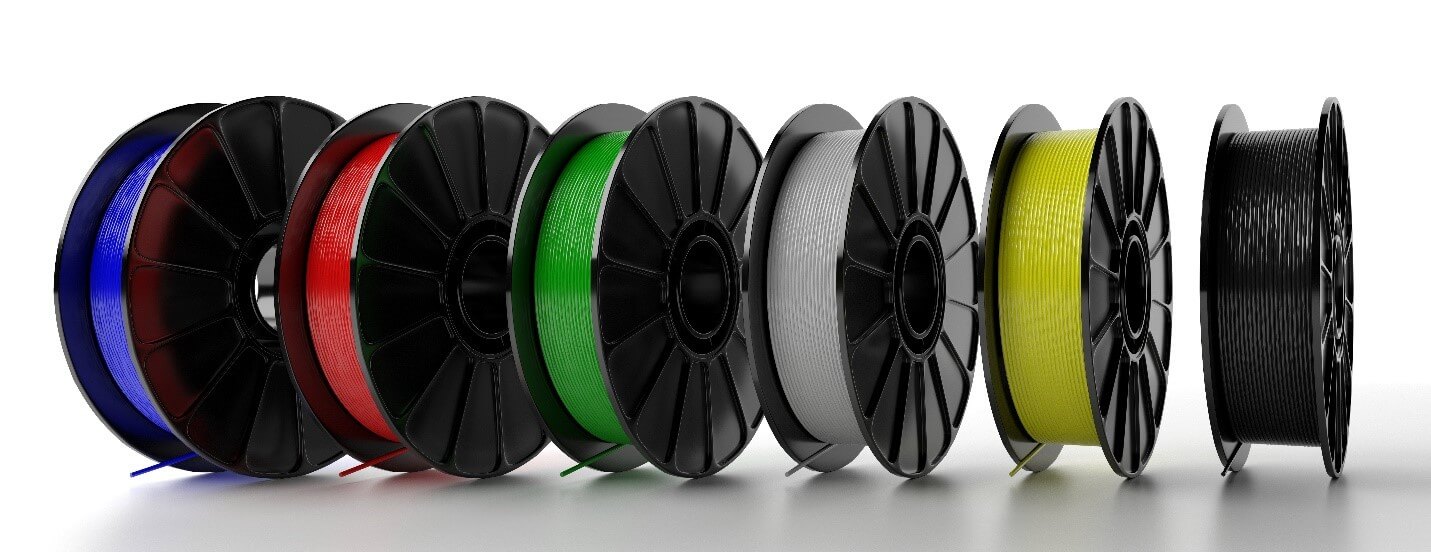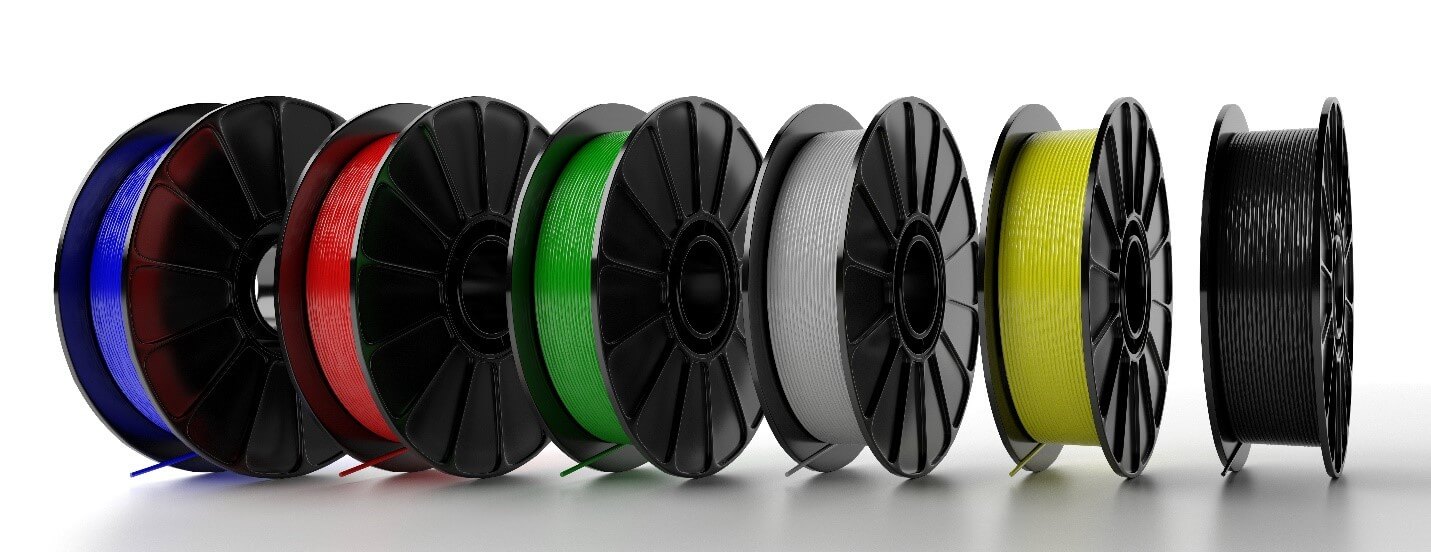Types of 3D Printer Filaments
The Different Types of Filaments Used in 3D Printing. Learn more now!
Introduction
3D Printing is an additive manufacturing process that generates three-dimensional parts from a digital product design. The process adds layers of material to create an object. Filament is a thermoplastic material used to print 3D objects with Fused Deposition Modeling (FDM) and Fused Filament Fabrication (FFF) 3D printers. It is available in various colors and materials, including PLA, ABS, PETG, and many others. Filament is typically wound onto a spool, then loaded into a 3D printer’s extruder.

PLA Filament
Polylactic Acid (PLA) is a biodegradable thermoplastic derived from renewable resources. These include materials such as cornstarch, tapioca roots, or sugarcane. PLA filament is a popular choice among 3D printing enthusiasts due to its ease of use and the fact that it is biodegradable and does not require a heated bed. The material is available in a variety of colors that are often used for prototypes, models, and small-scale production parts.
PLA Characteristics:
- Inexpensive
- Variety of Colors
- No Fumes Produced
- Less Prone to Warping
- Biodegradable
- Mediocre Mechanical Characteristics
ABS Filament
Acrylonitrile Butadiene Styrene (ABS) is one of the more common materials used in 3D Printing. ABS is typically used for parts that require more strength and durability than PLA. ABS filament is known for its ease of use and affordability.
ABS Characteristics:
- Inexpensive
- Strong
- Tough
- Chemical Stability
- Thermal Stability
- Toxic Fumes Produced
- Prone to Warping
Carbon Fiber Filament
Carbon fiber is developed from a combination of carbon fibers and plastic. It is a lightweight material often used in 3D printing to produce parts with superior strength and durability. Carbon fiber filament is typically more expensive than other filaments, but it offers a range of benefits in terms of strength and performance. It is often used in the manufacturing of aerospace and automotive parts. Carbon fiber filament can be used with a wide range of 3D printers, including FDM (Fused Deposition Modeling), SLA (Stereolithography), and SLS (Selective Laser Sintering).
Carbon Fiber Characteristics:
- Lightweight
- High Strength
- High Temperature Resistance
- Low Thermal Expansion
- Low Electrical Conductivity
- Chemical Resistance
- Expensive
- Difficult to Print
- Toxic Fumes
- Poor Printed Surface Finish
Nylon Filament
Nylon filament is acquired from polyamide, a strong, lightweight, and flexible synthetic polymer. It is often used to create parts that require strength and durability, such as gears, brackets, and other mechanical parts. Nylon is also resistant to wear and tear and can make items that require heat, chemical, and moisture resistance. It is also used to create objects with a smooth, glossy finish.
Nylon Characteristics:
- Strong
- Chemically Resistant
- Flexible
- Heat Resistant
- Prone to Warping
- Ultraviolet Degradation
- Prints at High Temperature
Flex Filament
Flex filament is designed for a higher degree of flexibility and elasticity than traditional filaments. Flex filament is made from a variety of materials, including TPU (thermoplastic polyurethane) and TPE (thermoplastic elastomer). It is most commonly used for printing prototypes, toys, or parts such as rubber seals and gaskets. Flex filaments are made of thermoplastic polyurethane (TPU) and can come in a variety of colors, sizes, and hardness.
Flex Characteristics:
- Durable
- Flexible
- Easy to Print
- Chemical Resistance
- Heat Resistance
- Low Strength
- Prone to Shrinkage
HIPS Filament
High-Impact Polystyrene (HIPS) is a thermoplastic polymer that is a cheaper alternative to ABS filament. It is frequently used for material support. It is used for prototypes, packaging, industrial parts, and medical equipment. HIPS is a strong and durable material that is easy to print with a low shrinkage rate, making it ideal for use in a variety of applications. It is often used as a support material for ABS or PLA prints.
HIPS Characteristics:
- Strong
- Impact Strength
- Durable
- Heat Stability
- Good Mechanical Properties
- Prints at Higher Temperatures
- Emits Styrene While Printing
- Prone to Warpage
Requires a Dual Extruder Printer
PVA Filament
Polyvinyl Alcohol (PVA) is a water-soluble filament used in dual extruder 3D printers to create intricate and detailed 3D prints. PVA is known for its excellent adhesion to other materials, making it perfect for building complex and highly detailed prints. It is commonly used as a support material to help create intricate structures or watertight structures.
PVA Characteristics:
- Bed Adhesion
- Dissolves in Water
- Biodegradable into Non-Toxic Compounds
- Requires Dual Extruder Printer
- Limited Print Temperature Window (185°C – 200°C)
PETG Filament
PETG is a modified version of polyethylene terephthalate (PET), a thermoplastic often used in food packaging, water bottles, mechanical parts, and other objects requiring durability and strength. This is due to its strong chemical resistance and durability. It is a reliable 3D printing material with good layer adhesion. It is easy to print and is a popular material.
PETG Characteristics:
- Flexibility
- Chemically Stable
- Impact Resistance
- Good for Clear Products
- Expensive
- Difficult to Finish
TPE Filament
TPE is a rubber-like material that can create objects with elastic properties. It is known for its flexibility, durability, and strong resistance to wear and tear. TPE filament is a popular choice for applications that require soft, flexible parts with excellent impact resistance.
TPE Characteristics:
- Flexible
- Strength
- Durability
- Chemical Resistance
- Easy to Print
- Less Expensive
- Abrasion Resistant
- Environmentally Friendly
- Poor adhesion
PC Filament
Polycarbonate (PC) is known for its superior strength and durability compared to other 3D printing filaments. PC Filament is often used for automotive parts, protective gear, and industrial components. It is also used for printing objects that require high levels of heat resistance, such as kitchen utensils and medical tools.
PC Characteristics:
- Strong
- Flexible
- Heat Stability
- Optical Qualities
- Prone to Abrasion
- Prints at High Temperature
Other filaments to consider include:
- TPU – Thermoplastic Polyurethane (TPU) is designed to provide enhanced flexibility and durability compared to other 3D printing materials. TPU filament is characterized by its low abrasiveness, reducing wear and tear on 3D printer components.
- PP – Polypropylene (PP) is a thermoplastic polymer that is lightweight, flexible, and known for its strength, durability, and affordability. PP features excellent chemical resistance, is non-toxic, and is one of the most common plastic materials used for everyday products. It is used to create items such as enclosures, medical parts, toys, fixtures, and mechanical parts, and it can also be used for food-safe applications.
- PEEK - Polyether Ether Ketone (PEEK) is exceptionally heat-resistant and strong thermoplastic. It creates robust and durable parts with excellent chemical resistance that can withstand temperatures up to 270°C. Peek Filament is suitable for a variety of aerospace, automotive, and medical applications.
- PEI - Polyetherimide (PEI) is a filament with good heat resistance, strength, and durability, making it ideal for printing parts that need to withstand high temperatures, such as engine components or parts that require a strong, rigid structure. Its strength and durability are coveted for medical and aerospace applications. Sheets of PEI are used on 3D printer beds for removal ease – it is an almost maintenance-free build surface for most filament types on heated and unheated printer beds.
Get multiple quotes for your parts in seconds
